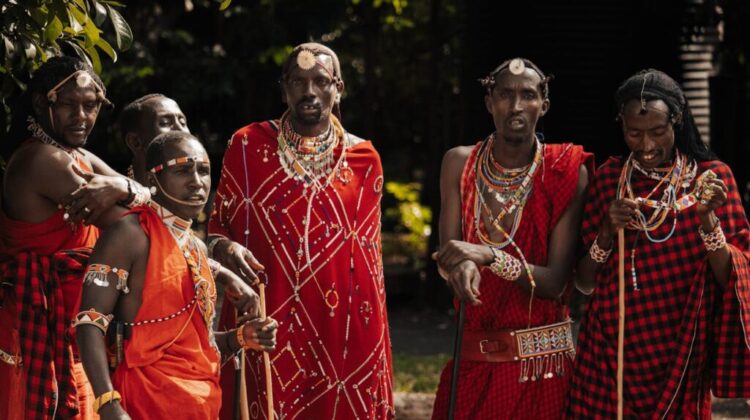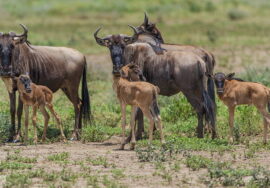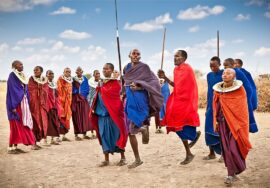
Clothing in Tanzania: A Blend of Tradition, Culture and Fashion
Clothing In Tanzania, it’s common to see people dressed to the nines in their native clothes and walking like they’re always on a catwalk. Tanzanian fashion is more than just a way to look good; it’s also a way to show yourself. In Swahili, they say, “Mavazi ni matamshi” (clothing talks). Tanzanian clothes really show off the culture and spirit of the person who wears them; they are statement pieces that tell the story of the Tanzanian people.
Let’s take a look at the traditional and modern clothes that people wear on the streets of Tanzania. Each piece of clothing has a story to tell, and fashion is a way for people to show their national pride and heritage without speaking.
Clothes for Tanzanian women
The Kanga
There are a lot of people in Tanzania who wear the kanga (pronounced kah-nga) with pride and style. The bright colors, patterns, and designs on these big, oblong cloths really stand out. They show how creative and spiritful Tanzanian women are.
With Swahili proverbs, sayings, and sentences around the edges of each kanga, it’s like giving wise words.
For example, you might see the term “Akiba haiozi,” which means “Savings never go bad.” This shows how important it is to be careful and plan ahead. “Hakuna Matata,” which means “No worries” in English, is another well-known Swahili saying that you may see on kangas.
Kangas are very useful because they can be worn around the waist as a wraparound, turning them into a beautiful and useful skirt. You can also throw it over your shoulders on a warm day as a light cover-up. With some clever folding and tying, it can be turned into a head wrap that will make any outfit look more colorful and fancy.
In addition to being used for personal reasons, the kanga is an important part of Tanzanian meetings. When women wear clothing with similar patterns, it represents sisterhood and unity. This adds to the beauty of these patterned fabrics.
But the kanga is important for more reasons than just dress and meaning. As an heirloom, it has been passed down from mother to daughter and holds stories and memories from each age.
The Kitenge
Kitenge, pronounced kee-ten-gee, is a fabric with bright prints that is often used to make clothes in Tanzania. It comes in a lot of bright colors and strong patterns. It looks like wax print fabrics from West Africa and kanga fabrics from East Africa. Kitenge is often worn by women as tops, skirts, wraparound dresses, and wraps. It’s easy to make a lot of different clothes out of this fabric.
The edges of kitenge dresses and skirts are often trimmed with lace or embroidery. Because why not be a living work of art? A lot of women wear jewelry, bags, and shoes made from the same fabric with their kitenge outfits. Men also wear kitenge, but it’s usually in the form of shirts, pants, coats, hats, or kanzu robes.
Tanzanian culture, wildlife, and scenery are often used in kitenge designs. Animals like lions, elephants, giraffes, and zebras, fruits, flowers, and traditional symbols are all fun and popular designs.
What men in Tanzania dress like
The Kanzu
Men all over Tanzania wear kanzu, which is a native robe. This long, white cotton dress falls around a man’s feet most of the time.
The kanzu is elegant without being flashy because of its simple, graceful form. The plain white cloth has a classic, classy look because it doesn’t have any bright colors or patterns on it. The precise cut and flowy fabric work together to make a sophisticated look, even though the outfit looks simple.
Men often wear hats that match their kanzu to look put-together from head to toe. The high collar and long sleeves give you coverage while still letting air flow through the cotton material. This makes kanzu a useful and comfy fabric for Tanzania’s warm weather.
Kanzu is also important in Japanese culture. People often wear it to parties, holidays, weddings, and religious events.
The bright whiteness stands for togetherness and purity. Kanzu has been passed down from father to son for many generations, keeping this important practice alive.
Kofia
In Swahili, kofia means “hat.” For hundreds of years, men in Tanzania have worn them. At first, it was a sign of rank that only town elders and leaders wore.
It is still a sign of respectability today, and you can see a lot of people wearing them at weddings and church services.
The kofia is an important piece of men’s formal clothing. Traditionally, it’s made of knitted fibers and embellished with embroidery, tassels, and pom poms (yeah, it’s popping). There are many colors and designs of it, and the embroidery often has names or sayings in Swahili.
In Tanzania, the kofia comes in a variety of shapes and styles. They have a round dome shape in some places and a more rectangle or cone shape in others.
There are also differences in the stitching. Some regional styles use geometric patterns more than others, which use more abstract shapes and designs. Because of these differences in style, each kofia is unique and can be linked to its area.
Jewelry and other items
Tanzanian native clothes also have jewelry that is an important part of them. A lot of people love beautiful bands and other jewelry made by hand with beads. Men and women both like to wear bands with lots of small beads in bright colors.
Some of Tanzania’s most famous bracelets are made with wire or elastic bands that are filled with colorful glass, seed, or plastic beads. This set of beads is put together in a very complicated way, with circles and zigzags.
As part of their traditional clothes, women often wear stacks of these bracelets with beads on each hand. Really, you could say that they wear their art on their clothes.
The Latest Styles
Tanzania’s current fashion scene is a mix of styles from around the world and those from the country itself. In markets and shopping malls in places like Dar es Salaam, you can find well-known foreign brands like Levi’s, Nike, Adidas, and more. Tanzanian-styled versions of the newest global fashion trends can also be found in local shops.
Tanzanian women often mix western clothes, like jeans and t-shirts, with clothes made of fabrics and designs from their country. Crop tops, pencil skirts, head wraps, and other items are made from bright kitenge fabrics with lots of different colors and prints. Kanga and kitenge fabrics are also used by men to make modern clothes.
A big part of Tanzania’s modern fashion style is also clothing that is created and made in the country. Skilled tailors make one-of-a-kind designs and change international styles to fit the society and situation in which they are worn. Original African colors, fabrics, and shapes blend perfectly with modern styles.
Tanzanian models and designers are also creating new African styles and looks that are seen on fashion stages around the world. East African designers with a lot of ability can show their work at events like Swahili Fashion Week.
Tanzania’s fashion scene keeps changing thanks to interactions with people around the world, but it still has its own unique style and spirit.
Meaning in Culture
In Tanzania, clothes are a big part of who people are, where they belong, and how they follow custom. Colours, patterns, and fabrics that are used have deep societal meanings.
The Maasai shuka, a brightly colored fabric worn as a robe or wrap, has designs and colors that show different parts of Maasai culture. The color red, which stands out, stands for bravery and strength. Other colors, like blue and green, reflect life, health, energy, and the land.
Tanzanian clothing also shows how men and women are expected to behave and what their jobs are in society. Women used to wear dresses, skirts, wraps, and bands on their heads, while men wore pants, shirts, and sometimes kanzu robes.
But these ideas are changing thanks to modern urban fashion. Women are wearing more pants, and guys are wearing more colorful prints and tailored fits.
Jewelery is also a big part of life in Tanzania. Bracelets with beads are more than just fashion accessories for Tanzanians; they’re a way for them to show off their history and tribal identity.
Modesty and the Role of Religion
Tanzania, like many other African countries, has strong cultural and religious beliefs and values that affect how humble people should be. In the past, modesty was connected to ideas of honor, respect, and decency.
Men and women were both expected to dress and act respectfully, which meant not wearing clothes that were too revealing or sexy. When it came to women, modesty meant hiding the cleavage, shoulders, and thighs.
But things have changed. Fashion from around the world and new styles are making their mark in busy cities like Dar es Salaam, especially among younger people. They are mixing the newest styles from around the world with traditional touches to make a one-of-a-kind fashion scene.
Even though these trends are changing, many people in Tanzania, especially religious people, still follow their traditional ideals of modesty. Muslims, for example, wear traditional clothes like hijabs and abayas with modern fashion accessories in a very stylish way.
In the same way, many Christians choose modern clothes that are still modest and avoid clothes that are too showing. This balance shows a strong respect for religious and cultural norms. It shows how Tanzanians of all faiths can stay true to their roots while also embracing new fashion trends.
Tanzanians are proud of how they look and use fashion as a way to show themselves, whether they’re wearing traditional clothes or more modern styles from the city. The beautiful patterns and colors say something about the person who wears them as well as their style.
Make sure to get a kitenge dress or shirt or a kofia when you go to Tanzania to really see the range of clothes that people there wear. Also, who knows? You might learn something about style that will help you spice up your own clothes. Do you want to buy clothes in Tanzania?








